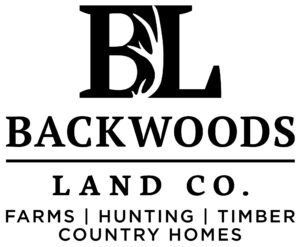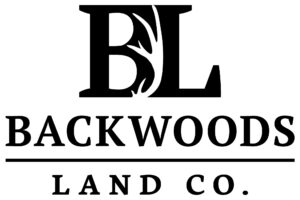GUIDE TO LAND BUYING

There are many factors that come into play when forming a opinion of value of land. Whether it be a one-acre lot or a sprawling 500 acre land tract, all lots and tracts of land were created unequal.
This is a general overview that can applied to most types whether searching for recreational, farm, timber and other types of land.
OPEN LEGAL ACCESS
Landlocked property means that there is no current legal access to the property to a public road. If the property is landlocked, knock off at least 50% of value. However, it does not mean that there is no potential access to the property. There is always access! How costly depends on many factors. The most obvious being the location of the parcel to the nearest public road.
In the case below there is a public road very close from the outlined landlocked parcel. Cost should reasonable, depending on your area and other factors to be grantedan easement in this situation. There is no such thing as ‘no access’, rather ‘no access currently’ as you will be able to gain access through a granted easement. For someone willing to endure the time and expense, there are potiental profits in landllocked parcels.
In the case below there is a public road very close from the outlined landlocked parcel of land. Depending on adjacent landowner puchback, costs should be reasonable to obtain easement access.

What about this one?

Hopefully, someone, the adjoining vacant landowner AND one of the parcels with homes will grant access. If not, then this could potentially be much more complicated and costly.
Besides being landlocked, some of the potential factors or value drivers when considering purchasing a piece of land is the legal access. Is there access to a public road? Is it legal? Is there an easement? Is it legal?
Many other factors can influence land value, however, access, especially no current access, is one of the most obvious. Financing may be difficult as well. Maintenance agreements for home construction, legal access and other issues pertaining to land access is some things to consider when searching for land to purchase.
TOPOGRAPHY
Topography plays a key role in determining land value. If you have tract of land near ongoing residential development that is hilly, rugged or sloped etc., the cost to develop would be substantially higher than one that is generally level. Although in some areas, building into rugged rocky land is a sought-after aesthetic feature.
One of the most renowned architects of our time, Frank Lloyd Wright inspired generations of home architects, builders and designers that incorporated the blending the structure into the environment. The result is some of the most awe-inspiring buildings you will ever see, such as this one.
SHAPE
The shape of the land can a have a huge impact on value. Consider the below property shapes.
The top land shape would likely be the more valuable to the typical prudent buyer due to layout of the land. There is frontage that lends itself to development due the lsyout of the first property. It has what could be considered and extra lot abutting the rut while the second property (bottom) would likely have very little potential within the typical rediential neighborhood.

For a 100 acre property with 20 year merchantable timber stands, shape can coincide with ingress and egress, interior road systems as well as frontage to a pubic road. If the interim use is for timber investment and the future use is possible development, then shape can much of a factor in the buying decision of timberland.
Shape can make the difference between a profitable land investment and a poor one. Investigating potential uses that can be derived from the shape of the land can earn dividends.
LOCATION & SIZE
Location is an obvious factor in choosing a piece of land. A 500 acre tract of land near town where development is occurring may have high development potential while the same tract 15 miles outside of town may be more suitable for cropland, cattle and other farming operations.
A 40 acre tract 15 miles outside of the city may be suited for a hobby farm or hunting land. Maybe a place for family and friends to gather and congregate. Or maybe just a place to fish, hunt, trail ride and/or to pass along to a future generation.
Value per acre will generally decrease the larger the tract of land you are purchasing due to diminished returns or utility.
The Dictionary of Real Estate Appraisal defines “diminishing utility” as “the concept that the consumption of each succeeding unit of economic good yields less satisfaction than the preceding unit. Marginal utility discussed in the Dictionary of Real Estate, is the additional satisfaction or benefit (utility) that a consumer derives from buying an additional unit of a commodity or service. The concept implies that the utility or benefit to a consumer of an additional unit of a product is inversely related to the number of units of that product he already owns. The more the land the less per acre would pay vs. a smaller similar tract on average.
WILDLIFE
A diverse array of vegetation, transitions in topography, water sources such as streams or creeks, sanctuaries and cover, lends itself for support for of wide spectrum of wildlife and are ideal for buyers of recreational property for hunting purposes. Rock outcroppings are also typically an attractive feature for buyers of land for wildlife purpose and for aesthetic value.
ZONING
Zoning can be an important factor in determining land value. What kind of restrictions exist within the zoning district? Some agricultural zoning districts limit the density of agricultural uses. Many limit the type and size of structures built upon the land. They are typically not limited to residential uses and included churches, schools, feed stores, kennels, hospitals, offices and other general commercial or special uses.
SOIL TYPE
Bedrock and sand are some of the best soil types to build structures on. One of the qualities that these two soils have in common that make them good choices for building is that they are good for allowing water to drain away from a building.
Loamy soils are good for building and is also ideal for growing crops such as wheat and vegetables such as cotton. Loamy soils make up a large portion of the North and Central Mississippi area.
Clay soils on other hand, are generally the worst type of soil to build on. When clay is moist it becomes pliable, making it easier to move. when this happens, it puts a great deal of pressure on a foundation, causing them to crack.
GUIDE TO LAND BUYING Read More »

